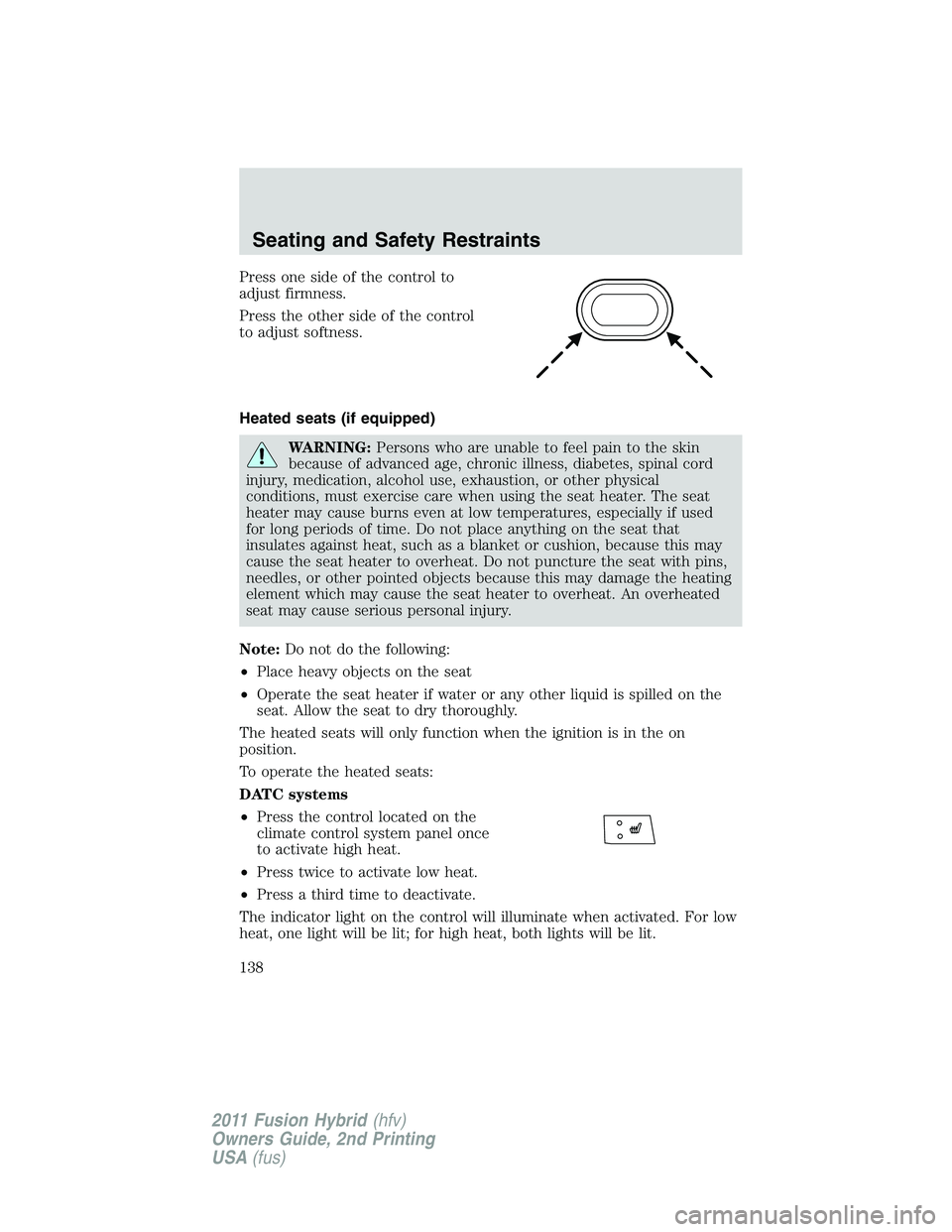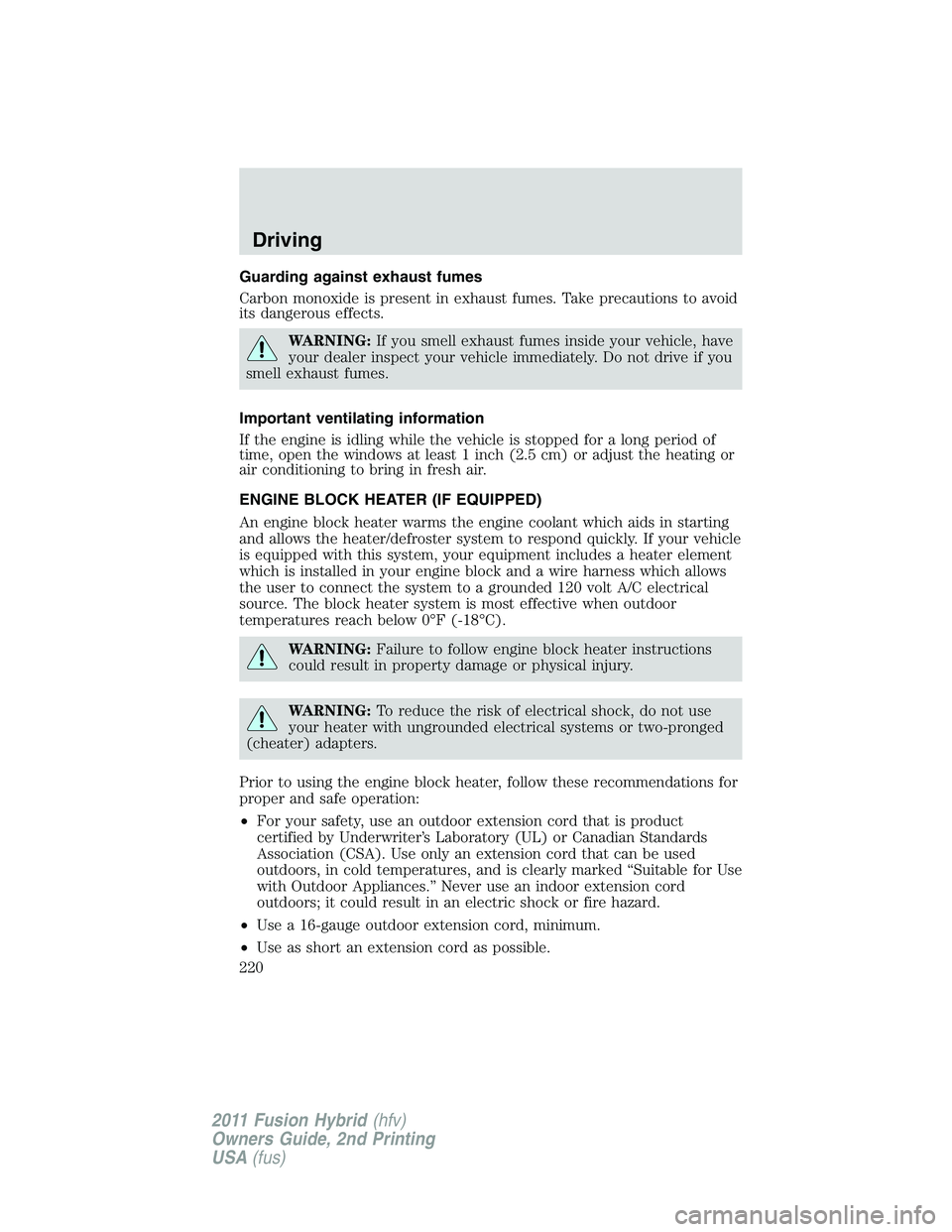2011 FORD FUSION HYBRID heater
[x] Cancel search: heaterPage 91 of 345

4. Press and release the 7 and 9
radio preset buttons together,
repeatedly until ZONE XX changes
to the correct zone (1–15) in the
CID.
5. The direction will display after
the buttons are released. The zone
is now updated.
Compass calibration adjustment
Perform compass calibration in an open area free from steel structures
and high voltage lines. For optimum calibration, turn off all electrical
accessories (heater/air conditioning, wipers, etc.) and make sure all
vehicle doors are shut.
1. Start the vehicle.
2. To calibrate, press and hold the 7
and 9 radio preset buttons together
for approximately 10 seconds until
CAL appears. Release the buttons.
3. Slowly drive the vehicle in a
circle (less than 3 mph [5 km/h])
until the CAL display changes to the
direction value (N, S, E, W, etc.). It
may take up to five circles to
complete calibration.
4. The compass is now calibrated.
Driver Controls
91
2011 Fusion Hybrid(hfv)
Owners Guide, 2nd Printing
USA(fus)
Page 138 of 345

Press one side of the control to
adjust firmness.
Press the other side of the control
to adjust softness.
Heated seats (if equipped)
WARNING:Persons who are unable to feel pain to the skin
because of advanced age, chronic illness, diabetes, spinal cord
injury, medication, alcohol use, exhaustion, or other physical
conditions, must exercise care when using the seat heater. The seat
heater may cause burns even at low temperatures, especially if used
for long periods of time. Do not place anything on the seat that
insulates against heat, such as a blanket or cushion, because this may
cause the seat heater to overheat. Do not puncture the seat with pins,
needles, or other pointed objects because this may damage the heating
element which may cause the seat heater to overheat. An overheated
seat may cause serious personal injury.
Note:Do not do the following:
•Place heavy objects on the seat
•Operate the seat heater if water or any other liquid is spilled on the
seat. Allow the seat to dry thoroughly.
The heated seats will only function when the ignition is in the on
position.
To operate the heated seats:
DATC systems
•Press the control located on the
climate control system panel once
to activate high heat.
•Press twice to activate low heat.
•Press a third time to deactivate.
The indicator light on the control will illuminate when activated. For low
heat, one light will be lit; for high heat, both lights will be lit.
Seating and Safety Restraints
138
2011 Fusion Hybrid(hfv)
Owners Guide, 2nd Printing
USA(fus)
Page 220 of 345

Guarding against exhaust fumes
Carbon monoxide is present in exhaust fumes. Take precautions to avoid
its dangerous effects.
WARNING:If you smell exhaust fumes inside your vehicle, have
your dealer inspect your vehicle immediately. Do not drive if you
smell exhaust fumes.
Important ventilating information
If the engine is idling while the vehicle is stopped for a long period of
time, open the windows at least 1 inch (2.5 cm) or adjust the heating or
air conditioning to bring in fresh air.
ENGINE BLOCK HEATER (IF EQUIPPED)
An engine block heater warms the engine coolant which aids in starting
and allows the heater/defroster system to respond quickly. If your vehicle
is equipped with this system, your equipment includes a heater element
which is installed in your engine block and a wire harness which allows
the user to connect the system to a grounded 120 volt A/C electrical
source. The block heater system is most effective when outdoor
temperatures reach below 0°F (-18°C).
WARNING:Failure to follow engine block heater instructions
could result in property damage or physical injury.
WARNING:To reduce the risk of electrical shock, do not use
your heater with ungrounded electrical systems or two-pronged
(cheater) adapters.
Prior to using the engine block heater, follow these recommendations for
proper and safe operation:
•For your safety, use an outdoor extension cord that is product
certified by Underwriter’s Laboratory (UL) or Canadian Standards
Association (CSA). Use only an extension cord that can be used
outdoors, in cold temperatures, and is clearly marked “Suitable for Use
with Outdoor Appliances.” Never use an indoor extension cord
outdoors; it could result in an electric shock or fire hazard.
•Use a 16-gauge outdoor extension cord, minimum.
•Use as short an extension cord as possible.
Driving
220
2011 Fusion Hybrid(hfv)
Owners Guide, 2nd Printing
USA(fus)
Page 221 of 345

•Do not use multiple extension cords. Instead, use one extension cord
which is long enough to reach from the engine block heater cord to
the outlet without stretching.
•Make certain that the extension cord is in excellent condition (not
patched or spliced). Store your extension cord indoors at
temperatures above 32°F (0°C). Outdoor conditions can deteriorate
extension cords over a period of time.
•To reduce the risk of electrical shock, do not use your heater with
ungrounded electrical systems or two pronged (cheater) adapters.
Also ensure that the block heater, especially the cord, is in good
condition before use.
•Make sure that when in operation, the extension cord plug/engine
block heater cord plug connection is free and clear of water in order
to prevent possible shock or fire.
•Be sure that areas where the vehicle is parked are clean and clear of
all combustibles such as petroleum products, dust, rags, paper and
similar items.
•Be sure that the engine block heater, heater cord and extension cord
are solidly connected. A poor connection can cause the cord to
become very hot and may result in an electrical shock or fire. Be sure
to check for heat anywhere in the electrical hookup once the system
has been operating for approximately a half hour.
•Finally, have the engine block heater system checked during your fall
tune-up to be sure it’s in good working order.
How to use the engine block heater
Ensure the receptacle terminals are clean and dry prior to use. To clean
them, use a dry cloth.
Depending on the type of factory installed equipment, your engine block
heater will use .4 to 1.0 kilowatt-hours of energy per hour of use. Your
factory installed block heater system does not have a thermostat;
however, maximum temperature is attained after approximately three
hours of operation. Block heater operation longer than three hours will
not improve system performance and will unnecessarily use additional
electricity.
Make sure system is unplugged and properly stowed before driving the
vehicle. While not in use, make sure the protective cover seals the
prongs of the engine block heater cord plug.
BRAKES
Occasional brake noise is normal. If a metal-to-metal, continuous grinding
or continuous squeal sound is present, the brake linings may be worn-out
Driving
221
2011 Fusion Hybrid(hfv)
Owners Guide, 2nd Printing
USA(fus)
Page 251 of 345

If the battery has been disconnected and reconnected, refer to the
Batterysection of theMaintenance and Specificationschapter.
The high-current fuses are coded as follows.
Fuse/Relay
LocationFuse Amp
RatingProtected Circuits
1 50A* Electronic power assist steering B+
2 50A* Electronic power assist steering B+
3 40A* Powertrain control module (aux relay
5 power)
4 — Not used
5 — Not used
6 40A* Rear defrost (aux relay 4 power)
7 40A* Vacuum pump (aux relay 6 power)
8 50A* Brake system controller pump
9 20A* Wiper washer
10 30A* Brake system controller valves
11 — Not used
12 — Not used
13 15A** Motor electronics coolant/heater
pump (relay 42 & 44 power)
14 — Not used
Roadside Emergencies
251
2011 Fusion Hybrid(hfv)
Owners Guide, 2nd Printing
USA(fus)
Page 252 of 345

Fuse/Relay
LocationFuse Amp
RatingProtected Circuits
15 — Not used
16 — Not used
17 10A** HEV high voltage battery module
18 30A* 110V electrical outlet
19 — Not used
20 — Not used
21 — Not used
22 20A* Console power point
23 10A** Powertrain control module/
Transmission control module
keep-alive power, Canister vent
24 — Not used
25 — Not used
26 — Not used
27 — Not used
28 60A* Cooling fan motor
29 20A* Front power point
30 30A* Fuel relay (relay 43 power)
31 30A* Passenger power seat
32 30A* Driver power seat
33 20A* Moon roof
34 — Not used
35 40A* Front A/C blower motor (aux relay 3
power)
36 1A Diode Fuel pump
37 5A** Vacuum pump monitoring
38 10A** Heated side mirrors
39 10A** Transmission control module
40 10A** Powertrain control module
41 G8VA relay Backup lamps
42 G8VA relay Heater pump
Roadside Emergencies
252
2011 Fusion Hybrid(hfv)
Owners Guide, 2nd Printing
USA(fus)
Page 253 of 345

Fuse/Relay
LocationFuse Amp
RatingProtected Circuits
43 G8VA relay Fuel pump
44 G8VA relay Motor electronics coolant pump
45 15A** Injectors
46 15A** Coil on plugs
47 10A** Powertrain control module (general):
Heater pump, Motor electronics
coolant pump relay coils, DC/DC
converter, Back-up lamps, Brake
controller
48 20A** HEV high voltage battery module,
Fuel pump relay
4915A** Powertrain control module (emissions
related)
* Cartridge Fuses ** Mini Fuses
Auxiliary relay box
The auxiliary relay box is located in front of the radiator in the engine
compartment.
The components are coded as follows:
Relay Location Relay Type Function
1 — Not used
2 — Not used
3 High current
microBlower motor
Roadside Emergencies
253
2011 Fusion Hybrid(hfv)
Owners Guide, 2nd Printing
USA(fus)
Page 262 of 345

4. Check all battery terminals and remove any excessive corrosion before
you attach the battery cables. Ensure that vent caps are tight and level.
5. Turn the heater fan on in both vehicles to protect from any electrical
surges. Turn all other accessories off.
Connecting the jumper cables
Note:In the illustration, the vehicle on the bottom is used to designate
the assisting (boosting) battery.
1. Connect the positive (+) jumper
cable to the positive (+) terminal of
the discharged battery.
2. Connect the other end of the
positive (+) cable to the positive
(+) terminal of the assisting battery.
3. Connect the negative (-) cable to
the negative (-) terminal of the
assisting battery.
4. Make the final connection of the
negative (-) cable to an exposed
metal part of the stalled vehicle’s
engine, away from the battery and
the carburetor/fuel injection system.
Note:Do not attach the negative (-) cable to fuel lines, engine rocker
covers, the intake manifold or electrical components as grounding points.
WARNING:Do not connect the end of the second cable to the
negative (-) terminal of the battery to be jumped. A spark may
cause an explosion of the gases that surround the battery.
Ensure that the cables are clear of fan blades, belts, moving parts of both
engines, or any fuel delivery system parts.
Jump starting
1. Start the engine of the booster vehicle and run the engine at
moderately increased speed.
+–
+–
2
3
14
Roadside Emergencies
262
2011 Fusion Hybrid(hfv)
Owners Guide, 2nd Printing
USA(fus)